The Easiest Way to Gather Patient Video Testimonials


As a healthcare provider, you know that your patients are your best advocates.
Patient video testimonials are a powerful way to showcase the difference that you’ve made in your patients’ lives.
There is a tool that lets you collect patient video testimonials easily without any experience in video production.
Read more to find out how to implement it!
What Are Patient Testimonial Videos?
Patient testimonial videos are a “sub-genre” of customer video reviews.
In a patient video testimonial, your satisfied customer (=patient) tells about their positive experience regarding your healthcare service, clinic, or procedure.
Video is highly effective, since it creates an emotional connection and really gets into people’s feelings in a different way than written testimonials.
When you see the person’s expressions and hear their voice when they tell you how their life has changed after a successful treatment, you simply cannot stay cold.
And when you are looking for a new dentist, or perhaps a plastic surgeon to do your next procedure, you will surely look for experiences from previous customers.
You can find the testimonials on social media channels or on the clinic’s website.
The videos build trust and make you want to see the same healthcare provider yourself!
Check out alse these stats about video testimonials:
- According to 70% of marketers video converts better than any other medium
- Video is used by 86% of businesses to help market their product or service
- 93% of marketers say that video on social media has helped them get new customers
- 99% of marketers stated in 2020 that they plan on using video as part of their digital marketing the next year, too.
Why Patient Testimonials Matter in Healthcare
Patient testimonials are more than just kind words; they’re a powerful tool that can shape the perception of your healthcare practice.
Let’s explore the benefits of patient testimonials and why they’re crucial for building trust, attracting new patients, and enhancing your practice’s reputation.
1. Build Trust and Credibility
In healthcare, trust is everything. When potential patients see genuine testimonials from others who have had positive experiences, they’re more likely to trust your practice. Testimonials serve as social proof, assuring new patients that they’re making the right choice by choosing your services.
2. Improve Patient Engagement
Patient testimonials encourage engagement by making your practice feel more relatable. When people read about others’ experiences, they’re more likely to connect emotionally with your practice. This connection can lead to higher patient satisfaction and loyalty.
3. Boost Online Presence
Positive testimonials are great for your online reputation. They improve your visibility in search engines and make your practice stand out on review sites. A strong online presence is essential for attracting new patients who rely on the internet to find healthcare providers.
4. Encourage Referrals
Satisfied patients who share their positive experiences can lead to more referrals. Testimonials act as word-of-mouth marketing, which is one of the most effective forms of advertising in healthcare.
5. Enhance Marketing Efforts
Patient testimonials can be used across various marketing channels, including your website, social media, and print materials. They add a personal touch to your marketing efforts, making them more impactful.
6. Provide Valuable Feedback
Testimonials often highlight what your practice is doing well and where there’s room for improvement. This feedback is invaluable for continuous improvement and maintaining high standards of patient care.
Short Patient Testimonials Video Examples
A few tangible examples are always a good idea, am I right?
Here’s 5 examples of different patient or customer testimonial videos, which show how different techniques can be used to produce patient video testimonials.
1. Experiences of Medical Equipment
Patient testimonials about medical equipment are very similar to any customer product review.
However, they have a very specific target audience: those people who also need to use the specific equipment.
Oftentimes these people are experts on the condition in question and the required equipment.
This means that your patient testimonial video needs to address the right issues and really dig into the benefits of your product. Generic praise does nothing.
In this example, a former professional athlete Kendall Simmons talks about his diabetes and experience with ExpressionMed medical tapes.
The video is professionally produced, and includes a lot of B-roll footage.
Simmons talks about his career, challenges with diabetes, and also what makes these particular medical tapes superior.
2. Surgery Patient Testimonial Video
Good surgeons are sought after. For that reason, patient testimonial videos are a great investment and addition to your marketing efforts.
In this example video, a patient tells about what issue he had and how it affected his life. Then he explains how he found the doctor in question, and how happy he was with the outcome and the doctor’s work.
As you can see, the video is “home-made” and likely shot with a phone. The format is simple, yet effective!
These types of videos are extremely easy and cost-effective to collect with video testimonial apps.
3. Dental Patient Testimonials
Dental patient testimonials come from patients who have had nice experiences at the dentist.
These testimonials often highlight how well the staff was reacting to the patient’s fears and anxieties regarding dental treatments.
Of course, the end result is important here as well.
In this example, the patient starts with a recommendation and proceeds to describe what makes him especially happy with the service.
The video is short and concise – no doubt the potential customers will have the patience to watch it through!
Don't forget the importance of Google reviews for dentists!
4. Cancer Patient Testimonial Video
Surviving from cancer and other scary diseases makes a very emotional story.
This video testimonial takes a quite cinematic approach to a cancer patient story. The patient talks a lot about his feelings and thoughts during the difficult period of his life, on top of what he is experiencing physically because of a lymphedema.
In the end, he introduces the device which he uses to alleviate his discomforts, and allows him to live a normal life.
This is another professional video, which can be seen from the way the storyline is constructed, how music is chosen, and from the used footage.
Also, the patient's own personality shines through, and the way he uses words skillfully.
5. Physiotherapy Patient Video Testimonial
A patient experience in physiotherapy or other similar treatment has special characteristics compared to e.g. surgeons or dentists.
In physiotherapy, especially during longer treatment periods, the patient and the physiotherapist have to spend some time together.
These kinds of testimonials are likely to highlight how encouraging, friendly and supportive the professional was.
In this example, a patient talks about how skillfully the physiotherapist was able to analyze his injury and help him get pain free.
The B-roll includes footage of the treatments, and the physiotherapist himself is present in the video.
The camera work and edit are likely DIY, but still look great!
Creating Glowing Patient Video Testimonials
Those were some great and creative videos!
You surely want to know how to create similar patient stories for your own practice.
Your wish has been heard!
There are three ways to make testimonial videos:
- Professional video production
- DIY
- Remote video with software
The professional video production process is quite long and expensive, but really worth it if you are looking for TV-worthy material.
If you are going to choose that option, you don’t really need to read this tutorial further – the production team will take over!

However, if you don’t want to purchase a video and decide go for the second option, here’s some practical advice.
Do's and Don'ts of Patient Video Testimonials
First of all, make sure that you are on the same page with the patient about how much you want to share. The patient should not feel uncomfortable or pressured to talk about something they would like to keep private.
Like discussed before, you can make special arrangements like not showing the patient’s face and only using B-roll imagery, or maybe even alter the voice if necessary.
Second, keep the video testimonial short and to the point. Patients should be able to share their story in a maximum of 2-3 minutes.
Thirdly, mind the background and other details. You can film at the patient’s home, at your clinic, or somewhere else.
You could film the patient doing something active or taking care of their family – whatever feels like a good addition to the video and reflects the story and the patient’s character!
And finally, make sure to choose the right interview questions that capture the story and make it engaging.
| Do: | Don’t: |
| Discuss with the patient how much they want to share. | Push the patient to talk about something they don’t want to and make them uncomfortable. |
| Keep it short and logical. | Rant too much and make the story difficult to follow. |
| Capture relevant B-roll footage if needed to create variety. | Make a long video with only one shot and set-up. |
| Choose the right interview questions to create structure and guide the interview. | Have no structure or questions at all. |
Patient Testimonial Questions
The questions should always be personalized to fit the situation.
Think about what you want to convey with the video, and consider the patient’s unique story.
Here’s a draft of some video testimonial questions that you could ask:
- Tell something about you: your name, age, location, profession, hobbies, something else relevant for the story.
- What was the health issue that you seeked help for?
- How long had you suffered from the issue?
- Has the health issue prevented you from doing something that you really enjoy, like a hobby or job?
- How did you come across this particular clinic/provider?
- Why did you choose this particular clinic/provider? What made it better compared to others?
- What was the experience like?
- How has your life changed since?
- Is there something you couldn’t do before, but can after the treatment?
It depends a lot on the person how much and how well they are going to speak. Some clients may need some extra push and more specific questions, while others are just naturally great at creating a story.
10 Tips for Getting More Testimonials from Patients
1. Ask at the Right Time
Timing is everything. Ask for testimonials shortly after a successful treatment or positive experience when the patient is most satisfied. This increases the likelihood of them agreeing to share their thoughts.
2. Make It Simple
Keep the process simple and stress-free. Provide multiple options for submitting testimonials, such as online forms, email, or even a quick text message. The easier it is, the more likely patients will share their experiences.
3. Use a Template
Some patients might not know what to say in a testimonial. Provide a simple template or a few guiding questions to help them articulate their experience. For example:
- What problem did you come in with?
- How did our team help you?
- How do you feel now after the treatment?
4. Request Testimonials in Person
Asking for testimonials during an in-person visit can be highly effective. When a patient expresses satisfaction, take the opportunity to ask if they would be willing to share their experience.
5. Send Follow-Up Emails
After a successful appointment, send a follow-up email thanking the patient and gently asking for a testimonial. Include a direct link to the testimonial submission form to make it convenient.
6. Highlight the Importance
Explain to your patients why their feedback is valuable. Let them know that their testimonial can help others make informed decisions and find the right healthcare provider.
7. Offer Multiple Platforms
Give patients the option to leave testimonials on different platforms, such as your website, Google, Facebook, or health-related review sites. This flexibility increases the chances of them leaving a review.
8. Respect Privacy
Always ask for permission before sharing a patient’s testimonial. If needed, offer the option to keep their identity anonymous to ensure they feel comfortable.
9. Use Video Testimonials
Video testimonials can be more impactful than written ones. If a patient is willing, record a short video where they share their experience. These can be shared on your website and social media channels.
10. Showcase Testimonials to Encourage Others
Display existing testimonials prominently on your website or in your office. When patients see others sharing their experiences, they may feel more inclined to contribute their own.
The Best Tool for Patient Video Testimonials
If you are a busy physician or just lack the resources and competency to produce video testimonials, worry not.
There is now a solution for people like you: remote video testimonials and video testimonial software.
You can use the Trustmary software to send digital testimonial requests, and collect written and video testimonials from your patients – for free!
Using the software is easy and effortless for you, but especially for the patient.

Step-by-Step Guide to Patient Testimonials
Here’s how it works:
- You create a satisfaction survey with the easy survey maker.
- You send the survey (automatically!) via email to your patients after a successful experience.
- The patient answers the survey with their honest opinion.
- The patients who give you a good score on the satisfaction survey get a testimonial request.
- They can write a testimonial or record a video testimonial immediately and directly in the same survey.
- You collect their personal information and permission to use the testimonial publicly.
- You can use the collected testimonial videos on your website or social media.

It’s that easy!
Bonus: While you collect testimonials, you also receive honest and authentic feedback from the patients, which helps you improve your business.
Conclusion
When used correctly, patient video testimonials can be a powerful marketing tool.
They can help you attract new patients and showcase the difference that you’ve made in the lives of your current patients.
You can either:
- Hire a professional team to make a video for you (great option if you have the resources and want top-notch quality)
- Record the video yourself while the patient is visiting the clinic (cheaper, but requires planning and some technical skills from your part)
- Implement a video testimonial software, such as Trustmary, that lets your clients create or download videos remotely!
In any case, the right questions are crucial for the success of the video. You can find great examples above.
And finally, let’s finish with some good news: Trustmary can get you unlimited written and video testimonials for free! Just sign up and start collecting feedback and testimonials right away!
Read more about customer video testimonials:
FAQ
Why patient feedback is important?
In order to grow your business and practice, you need to know if you are doing a good job. It is not just about the outcome, but also about customer service, facilities, and other small things. You don’t want bad word-of-mouth circulating around: you want to know about it yourself and improve!
Why testimonials are important?
Testimonials and reviews are a great source of social proof, and an effective marketing tool. Testimonials build trust for your business and help you get more customers.
How to get video testimonials from customers?
The first step to getting video testimonials is to ask for them. You can ask face-to-face or via email. You can also collect video testimonials via satisfaction surveys that you create with Trustmary! See additional tips on getting more video testimonials here.
How to add patient video testimonials on a website?
Adding Trustamary video testimonials to your website is easy. All you have to do is copy and paste a snippet of code. Another way is to upload them to e.g. Youtube and embed the video on your website.




